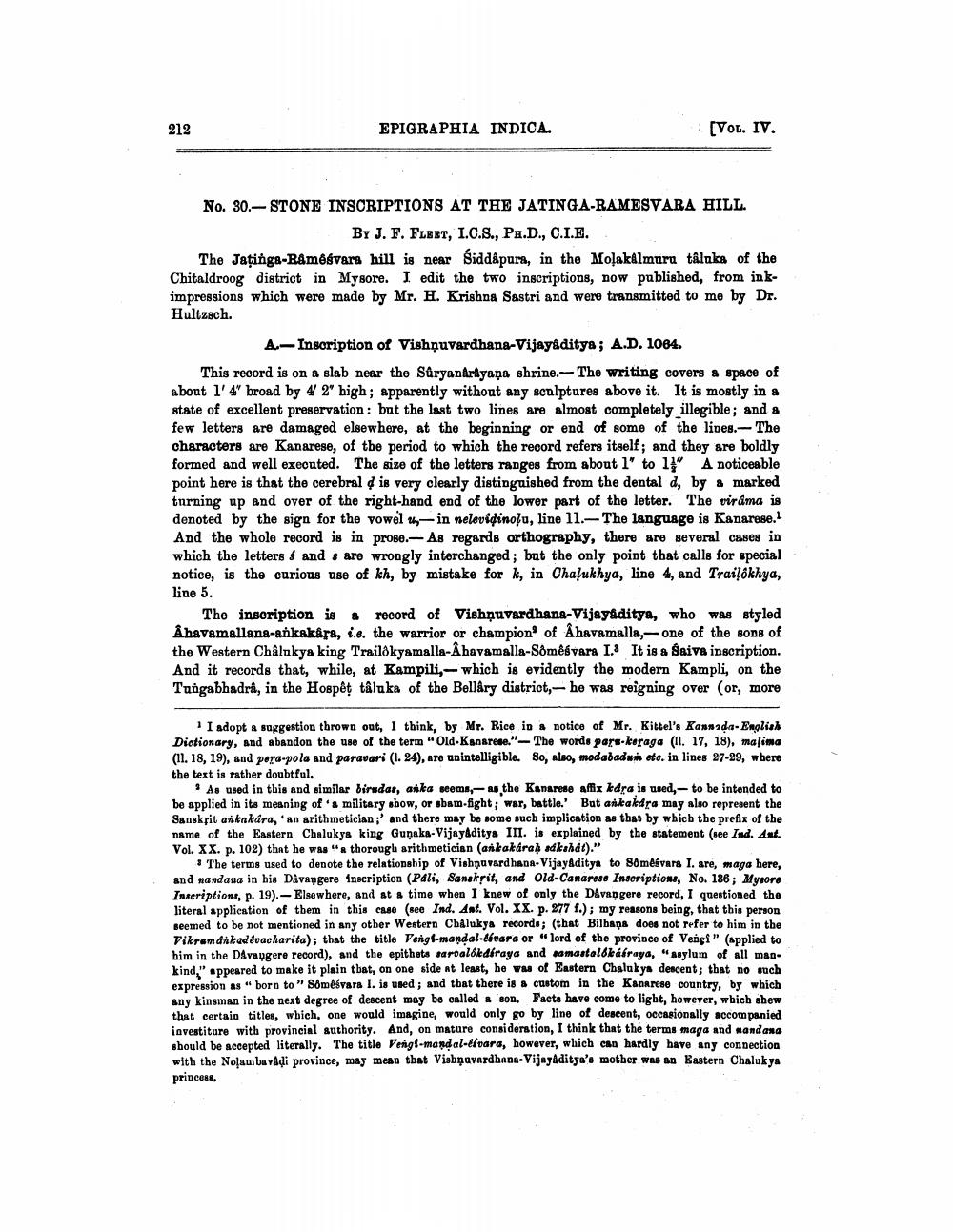________________
212
EPIGRAPHIA INDICA.
[Vol. IV.
No. 30.-- STONE INSCRIPTIONS AT THE JATINGA-RAMESVARA HILL.
Br J. F. Flest, I.C.S., PA.D., C.I.E. The Jatinga-Råmêsvara hill is near Siddapura, in the Moļakálmuru tâluka of the Chitaldroog district in Mysore. I edit the two inscriptions, now published, from inkimpressions which were made by Mr. H. Krishna Sastri and were transmitted to me by Dr. Hultzsch.
A.-Insoription of Vishnuvardhana-Vijayaditya; A.D. 1064.
This record is on a slab near the SüryanArtyaņa shrine.-The writing covers a space of about l' 4' broad by 4' 2' high; apparently without any sculptures above it. It is mostly in a state of excellent preservation: but the last two lines are almost completely illegible; and a few letters are damaged elsewhere, at the beginning or end of some of the lines. The characters are Kanarese, of the period to which the record refers itself; and they are boldly formed and well executed. The size of the letters ranges from about l' to 1" A noticeable point here is that the cerebral is very clearly distinguished from the dental d, by a marked turning up and over of the right-hand end of the lower part of the letter. The viráma is denoted by the sign for the vowel -in nelevidinolu, line 11.-The language is Kanarese. And the whole record is in probe.- As regards orthography, there are several cases in which the letters & and are wrongly interchanged; but the only point that calls for special notice, is the curious use of kh, by mistake for k, in Ohaļukhya, line 4, and Trailökhya, line 5.
The inscription is & record of Vishnuvardhana-Vijayaditya, who was styled Åhavamallana-ankakara, 1.e. the warrior or champion of Åhavamalla, one of the song of the Western Châlukya king Trailokyamalla-Ahavamalla-Somêsvara I. It is a Saiva inscription. And it records that, while, at Kampili,- which is evidently the modern Kampli, on the Tangabhadrâ, in the Hospet täluka of the Belláry district, he was reigning over (or, more
1 I adopt & suggestion thrown out, I think, by Mr. Rice in & notice of Mr. Kittel's Kannada - English Dictionary, and abandon the use of the term "Old-Kanarese." -The words pars-koraga (ll. 17, 18), malima (11.18, 19), and pora-pola and paravari (I. 24), are unintelligible. So, kleo, modabadu eto. in lines 27-29, where the text is rather doubtful.
As used in this and similar biridas, anka seems,- the Kanarese afix kedra is used, -to be intended to be applied in its meaning of 's military show, or sbam-fight; war, battle.' But ankakdra may also represent the Sanskrit ankakara, an arithmetician;' and there may be some such implication as that by wbicb the prefix of the name of the Eastern Chalukya king Gunaka-Vijayaditya III. is explained by the statement (see Ind. Ant. Vol. XX. p. 102) that he was "thorough arithmetician (ankakarah akahat)."
The terms used to denote the relationship of Vishnuvardhana-VijayAditya to 8ômesvara I. are, maga here, and nandana in his Davangere inscription (Pali, Sanskrit, and Old-Canarese Inscriptions, No. 136; Mysore Inscriptions, p. 19).- Elsewhere, and at a time when I knew of only the Davangere record, I questioned the literal application of them in this case (see Ind. Ant. Vol. XX. p. 277 f.); my reasons being, that this person seemed to be not mentioned in any other Western Chalukya records; (that Bilbang does not refer to him in the Vikramdakadéacharita), that the title Vengf-mandal-divara or lord of the province of Vengi" (applied to him in the Davangere record), and the epithets sardalókedóraya and samastalbkáfraya, "Asylum of all mag. kind," appeared to make it plain that, on one side at least, he was of Eastern Chalukya descent; that no such expression as born to Somesvara 1. is used; and that there is a custom in the Kanarese country, by which any kinsman in the next degree of descent may be called a son.Facts have come to light, however, which shew that certaio titles, which, one would imagine, would only go by line of descent, occasionally accompanied investiture with provincial authority. And, on mature consideration, I think that the terms maga and wandana should be accepted literally. The title Vengl-mandal-lávara, however, which can hardly have any connection with the Nolam bavadi province, may mean that Visbņavardhana-Vijayaditya's mother was an Eastern Chalukya princess.




